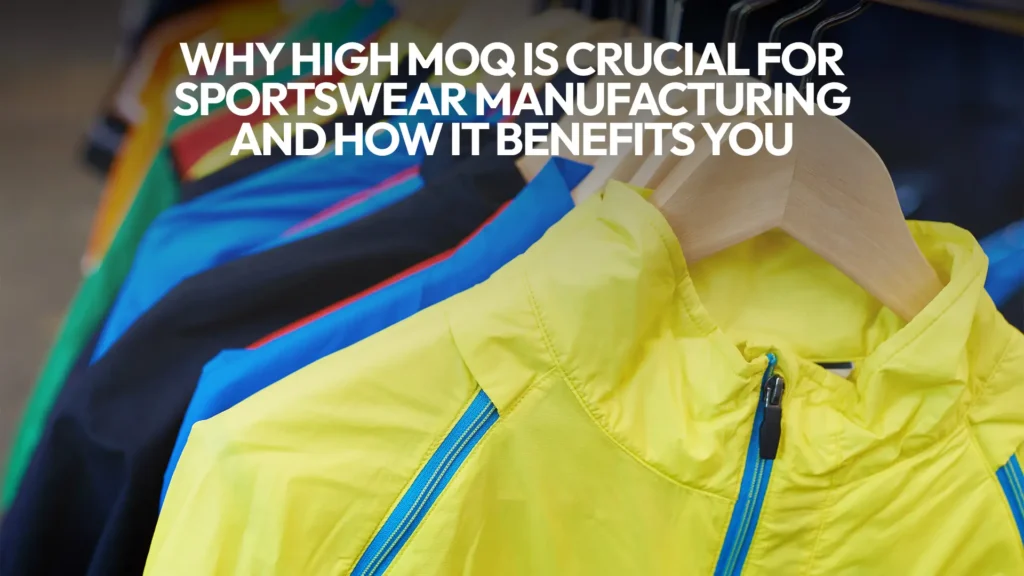Blog
Why High MOQ is Crucial for Sportswear Manufacturing and How It Benefits You
- August 5, 2024

Minimum Order Quantity (MOQ) is a fundamental concept in manufacturing, particularly in the sportswear manufacturing industry. MOQ represents the smallest number of sportswear units a manufacturer can produce in a single order. Understanding the importance of MOQ is crucial for both customers and manufacturers as it impacts production efficiency, cost management, and overall business success.
What Is Minimum Order Quantity (MOQ) and Why Is It Important?
MOQ is a term used in e-commerce to describe the minimum purchasing quantity a customer must order. MOQs benefit both retailers and manufacturers by ensuring production costs are covered and profitability is maintained. For customers, adhering to MOQ can lead to cost savings and better supplier relationships, resulting in better pricing and consistent product quality. Understanding and leveraging MOQ is crucial for balancing supply and demand, minimizing waste, and maximizing financial performance in the sportswear industry. By understanding and negotiating MOQs, businesses can optimize their production strategies, reduce per-unit costs, and improve inventory management.
Types of Minimum Order Quantity
Various types of MOQs are used in the sportswear manufacturing industry, including standard MOQ, high MOQ, and low MOQ. Each type has its benefits and challenges, depending on the business’s specific needs.
High Minimum Order Quantity (MOQ)
High MOQs offer several benefits, particularly for sportswear manufacturers. They ensure that production processes are optimized, reducing per-unit costs and improving efficiency. Producing in larger quantities allows manufacturers to allocate resources better, streamline operations, and achieve economies of scale.
Challenges
However, high MOQs can pose challenges for buyers, especially small sports businesses or startups, requiring significant upfront investment and increased storage space. Despite these challenges, high MOQs can lead to stronger manufacturer relationships and more favorable terms, ultimately benefiting both parties in the long run.
Low Minimum Order Quantity (MOQ)
Low MOQs provide greater flexibility for buyers, allowing them to place smaller customized sportswear design orders that align with immediate needs and reduce the risk of overstocking. This approach is particularly beneficial for small businesses and startups, as it lowers the financial barrier to entry and enables them to test the market with smaller quantities.
Challenges
For manufacturers, low MOQs may result in higher production costs per unit. However, this can be offset by the potential for more frequent orders and the ability to cater to a broader range of customers. By offering low MOQs, manufacturers can attract a diverse clientele and build long-term relationships with emerging brands.

Benefits of Minimum Order Quantity (MOQ)
Setting and adhering to Minimum Order Quantity offers numerous benefits for suppliers and buyers. It helps streamline manufacturing production processes, reduce costs, and improve supply chain efficiency.
Benefits for Suppliers
MOQ ensures that production runs are economically viable by covering fixed and variable costs. This approach reduces fabric waste and maintains a steady cash flow and profitability. Suppliers can achieve cost-effective production and optimize resource allocation by producing larger quantities.
Key Points:
- Economically viable production runs
- Reduction in waste
- Steady cash flow and profitability
Benefits for Buyers
Adhering to a high MOQ can lead to cost savings and better manufacturer relationships. Buyers can negotiate better prices and terms by ordering in bulk, leading to lower per-unit costs. Additionally, MOQ helps ensure consistent product quality and availability, enhancing customer satisfaction and brand reputation.
Key Points:
- Cost savings through bulk purchasing
- Improved supplier relationships
- Consistent product quality and availability
- Enhanced customer satisfaction and brand reputation
Benefits of High MOQ
High Minimum Order Quantities (MOQs) offer several benefits, particularly for manufacturers. They ensure that production processes are optimized, reducing per-unit costs and improving efficiency. Producing in larger quantities allows manufacturers to allocate resources better, streamline operations, and achieve economies of scale.
Optimized Production Processes
High MOQs ensure that production processes are streamlined and efficient. By committing to larger production runs, manufacturers can reduce setup times and minimize disruptions in the production line.
Reduced Per-Unit Costs
Producing in larger quantities allows manufacturers to reduce the cost per unit. This is achieved through economies of scale, where the fixed costs of production are spread over a larger number of units, resulting in lower overall costs.
Improved Resource Allocation
With high MOQs, manufacturers can allocate resources more effectively. This includes better management of raw materials, labor, and machinery, leading to enhanced operational efficiency.
Economies of Scale
Economies of scale are a significant benefit of high MOQs. As the order volume increases, the cost per unit decreases, making production more cost-effective and allowing manufacturers to offer competitive pricing.
Example
If a sportswear manufacturer sets an MOQ of 500 shirts, they will not take orders below this quantity to ensure the production is viable and profitable. Higher MOQs enable economies of scale, where the cost per unit decreases as the order volume increases.

Factors Influencing Minimum Order Quantity (MOQ)
Several factors influence the setting of MOQ, including raw material availability, order volume, production complexity, and market demand. Understanding these factors helps businesses negotiate better terms and optimize their production strategies.
Raw Materials
The availability and cost of raw materials significantly impact the setting of MOQ. Manufacturers must ensure they can source the necessary materials in sufficient quantities to meet production needs. By securing reliable suppliers and optimizing material usage, businesses can manage their MOQ more effectively and reduce production costs.
Example
If a sportswear manufacturer can purchase fabric in bulk at a lower cost, they can set a lower MOQ, benefiting both the manufacturer and the buyer.Order Volume
Order volume is another critical factor influencing MOQ. Larger order volumes allow manufacturers to achieve economies of scale, reducing per-unit costs and improving overall production efficiency. Businesses must balance their order volume with market demand and storage capacity to optimize their MOQ and maintain profitability.
Example
Regularly placing large orders allows a sportswear brand to negotiate better prices and terms with suppliers, leading to cost savings and improved profitability.How to Calculate Minimum Order Quantity (MOQ)
Calculating Minimum Order Quantity (MOQ) is essential for optimizing manufacturing processes, reducing costs, and ensuring efficient inventory management. Here’s a detailed guide on calculating MOQ, incorporating key steps and considerations.
Consider Demand
Understanding market demand is crucial when determining MOQ. Analyzing historical sales data, market trends, and seasonal fluctuations helps predict future demand accurately. This ensures your MOQ aligns with customer needs and avoids overproduction or stockouts.
Calculate Holding Costs
Holding costs, also known as carrying costs, include expenses related to storing unsold inventory. These costs can significantly impact your profitability, so accounting for them when calculating MOQ is essential. Holding costs include warehousing, insurance, and obsolescence costs.
Break-Even Point
The break-even point is where total production costs equal total revenue. Calculating the break-even point helps set a low MOQ that ensures profitable production runs. This involves understanding your fixed and variable costs and determining the minimum sales needed to cover these expenses.
Set Your MOQ
Using the data gathered from demand analysis, holding costs, and the break-even point, you can set an optimal MOQ. This MOQ should cover production costs, align with market demand, and minimize inventory holding costs. It’s essential to regularly review and adjust your MOQ based on market conditions and changes in production efficiency.
Why Do Manufacturers Use Minimum Order Quantity (MOQ)?
Sportswear manufacturers set MOQs to effectively manage production schedules, costs, and inventory. MOQs ensure that suppliers can cover their fixed and variable costs, such as raw materials, labor, and machine setup. This approach helps maintain a steady cash flow and ensures the economic viability of production runs.
Managing Production Schedules
MOQs help manufacturers plan and manage their production schedules efficiently. By setting a minimum order quantity, manufacturers can schedule production runs that are large enough to justify the time and resources required for setup and operation.
Covering Fixed and Variable Costs
MOQs ensure that manufacturers can cover both fixed and variable costs associated with production. Fixed costs include expenses such as machinery and facility maintenance, while variable costs encompass raw materials, labor, and other operational costs.
Maintaining Steady Cash Flow
By setting an MOQ, manufacturers can maintain a steady cash flow, which is crucial for sustaining business operations. Consistent order volumes help ensure that there is a predictable stream of revenue.
Ensuring Economic Viability
MOQs help guarantee the economic viability of production runs. By requiring a minimum quantity, manufacturers can avoid producing at a loss and ensure that each production run is profitable.
Example
A supplier might set a high MOQ to ensure they can purchase the best sportswear fabric in bulk, reducing per-unit costs and achieving better pricing from their suppliers. This benefits both the manufacturer and the customer, who can receive high-quality products at competitive prices. Additionally, MOQs help suppliers manage their inventory levels, reducing the risk of overproduction and excess stock.

How Does Minimum Order Quantity (MOQ) Impact Inventory?
MOQ profoundly impacts inventory management in sportswear manufacturing. High MOQs require businesses to hold larger inventories, which can lead to increased holding costs, such as warehousing, insurance, and security expenses. Balancing high and low MOQs is crucial for optimizing inventory management.
Example
Inventory management software can aid in accurately calculating and adjusting MOQs based on fluctuating costs, market conditions, and detailed order quantities. These platforms provide dashboards for visualizing key metrics, enabling businesses to maintain optimal inventory levels, reduce costs, and enhance overall product supply chain efficiency. By regularly reviewing and adapting MOQs, companies can manage their resources effectively, meet customer demands, and achieve sustainable profitability.
Conclusion
Understanding and managing Minimum Order Quantity (MOQ) is vital for optimizing inventory management and ensuring the success of sportswear manufacturing. Utilizing advanced inventory management software within an ERP platform can help businesses accurately calculate and adjust MOQs, effectively balancing costs and demands. By regularly reviewing and fine-tuning MOQs, businesses can maintain optimal inventory levels, reduce storage costs, and enhance supply chain efficiency. This strategic approach supports sustainable profitability and ensures customer satisfaction and strong supplier relationships.
Frequently Asked Questions
How can small businesses manage high MOQs?
Small sportswear businesses manage high MOQs by negotiating with suppliers for lower quantities or discounts, using forecasting tools to predict demand, and monitoring inventory levels. Cross-docking, bundling products, and sourcing excess stock from sportswear suppliers can also help. These strategies ensure efficient management of high MOQs and maintain smooth operations.
What is MOQ and How Can it Benefit Sportswear Business?
Minimum Order Quantity (MOQ), is the smallest number of items a sportswear manufacturer accepts for a production order. For example, if a sportswear manufacturer has an MOQ of 50 pieces per style, you must order at least 50 pieces of that style to meet their requirements. MOQs benefit sportswear businesses by ensuring cost-effective production, reducing per-unit costs, and maintaining strong supplier relationships. They also help in securing better pricing and ensuring consistent quality and availability of products. By meeting MOQs, sportswear businesses can optimize inventory management and improve profitability.
How to Choose the Right MOQ for Your Business?
Choosing the right MOQ for your business involves balancing several key factors to ensure profitability and efficiency. Consider inventory turnover (how often you replenish stock in a year. Higher turnover justifies a higher MOQ). Production costs; higher costs necessitate a higher MOQ to improve profit margins and free up working capital. Assess your storage space, as larger orders require more warehouse space and increase maintenance costs. Understand your target market; a high MOQ may deter customers who prefer smaller orders. For expensive products, a lower MOQ is more suitable. Lastly, align MOQs with your business goals; a lower MOQ boosts sales, while a higher one reduces sales order costs. By weighing these factors, you set an MOQ that supports profitability and meets market demands.
What is the difference between MOQ and EOQ?
MOQ (Minimum Order Quantity) and EOQ (Economic Order Quantity) are both inventory management terms, but they serve different purposes. MOQ is the smallest quantity a supplier will accept for a single order, ensuring they cover production and delivery costs. It’s a supplier-driven requirement that impacts how much a business must order at a minimum.
On the other hand, EOQ is a formula businesses use to determine the ideal order size that minimizes total inventory costs, including ordering and holding costs. EOQ is calculated based on demand rate, ordering cost, and holding cost, aiming to optimize inventory management and reduce overall expenses.
On the other hand, EOQ is a formula businesses use to determine the ideal order size that minimizes total inventory costs, including ordering and holding costs. EOQ is calculated based on demand rate, ordering cost, and holding cost, aiming to optimize inventory management and reduce overall expenses.
What challenges do high MOQs present for small businesses?
High MOQs present several challenges for small sportswear businesses. Firstly, they require significant upfront investment, which can strain cash flow and limit resources for other business operations. Secondly, high MOQs lead to overstocking, tying up capital in unsold inventory and increasing storage costs. Additionally, they limit flexibility, making it difficult to respond to market changes or introduce new products.
High MOQs may also deter potential customers who prefer smaller orders, impacting sales. Finally, managing large quantities of stock increases the risk of inventory obsolescence, leading to potential losses. These challenges make it essential for small businesses to carefully consider their ordering strategies.
High MOQs may also deter potential customers who prefer smaller orders, impacting sales. Finally, managing large quantities of stock increases the risk of inventory obsolescence, leading to potential losses. These challenges make it essential for small businesses to carefully consider their ordering strategies.
Facebook
LinkedIn
Email